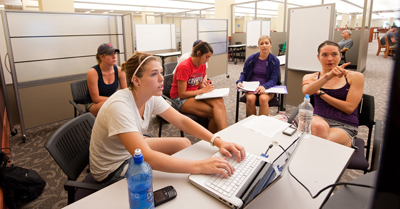SHIFTING FROM WHAT TO WHO
If you've been inside Hale Library in the last year, you've probably noticed some changes.
 Materials shifting, the opening up of a new entrance area, and the addition of flexible, mobile furniture and whiteboards are a few of the visible changes, but there's also been a great deal going on behind the scenes as well. Along with these physical changes are changes to the K-State Libraries organizational structure that help the libraries best meet the needs of K-State students and faculty.
Materials shifting, the opening up of a new entrance area, and the addition of flexible, mobile furniture and whiteboards are a few of the visible changes, but there's also been a great deal going on behind the scenes as well. Along with these physical changes are changes to the K-State Libraries organizational structure that help the libraries best meet the needs of K-State students and faculty.
Planning for all the changes began 2007 with the writing and adoption of a new strategic plan.
"The plan came out of a desire to tie the goals of the libraries to the organizational goals of K-State and to meet the needs of a rapidly changing academic information environment," said Lori A. Goetsch, dean of libraries. To make all these ideas come together, the libraries looked ahead to find places of convergence between their future and K-State's, Goetsch said. In doing so, they examined the expectations and needs of both students and faculty.
Meeting those expectations and fulfilling the goals of the strategic plan required a great number of changes. First came physical ones, including the renovation of Hale's 2nd floor and consolidation of library services into a single area.
"Over the past few years we've seen a steady increase in the number of students within Hale, particularly those doing collaborative projects and group study," Goetsch said. "It was an opportunity to reach a whole new cluster of people with access to the services, collections, technology and space the libraries offer."
Next came an organizational change, where libraries departments were taken apart and reassembled with a new, community-based emphasis. Traditionally, librarians who work directly with users have been grouped along discipline-based lines. In the new libraries structure, librarians are grouped by the communities they serve -- a switch in focus from the "what" to the "who."
Undergraduate and community services was one of the departments formed in the new structure. These librarians and staff focus on library instruction and reference services for K-State undergrads and also for community members who are served by K-State's land-grant mission.
"While our primary user base is K-Staters, we definitely have a mission to help community members who walk in and need the services that only an academic library can provide. Having staff focused on the community outside K-State will help us better anticipate those needs," Goetsch said.
Faculty and graduate students tend to have more in-depth or focused research needs than either undergraduates or community members, so a separate department was created to meet their needs, Goetsch said. Librarians in the faculty and graduate services department will assist with large, interdisciplinary projects like targeted excellence grants as well as individual research activities for publications, theses and dissertations. The five specialized branch libraries at K-State are also tied to this department.
University archives and special collections is another department with a strong focus on working with users. This department didn't make many structural changes in the reorganization, but expanded its mission to include new areas such as electronic records management and digital collections of archival materials, she said. These changes recognize the fact that some of the traditional output of the university has begun the move from paper to electronic form, and that this trend will continue in the future.
In addition to departments focused on helping users with their research and education goals, another group of three departments was created to work on acquiring, creating, describing and making available the wide variety of resources necessary for K-State students and faculty, Goetsch said.
Scholarly communications and publishing is one of those new departments. Among other projects related to scholarly communication, it manages the K-State Research Exchange, or K-REx, a shared repository to house the scholarly and research output of K-State.
"All graduate students submit their theses and dissertations to K-REx now," Goetsch said. "It allows them to retain their rights, and helps promote the work since the repository is open to searching online. We've seen multiple graduate student projects get hundreds and even thousands of downloads over the past few years."
In addition to K-State Research Exchange, the department also manages New Prairie Press, the libraries' scholarly open access journal imprint, and assists students and faculty with a variety of scholarly communications and copyright issues.
Librarians in the content development and acquisitions department are responsible for content selection for print and electronic resources across all subject areas. They respond both to direct requests from faculty for needed materials, and the changing needs of K-State as a whole as new programs and areas of study emerge. Other librarians and staff in this department handle interlibrary loan and document delivery, resource linking and licensing.
Finally, librarians and staff in the metadata and preservation department coordinate describing and caring for the libraries' collections, Goetsch said. They serve as campus experts on matters related to metadata and preservation and create a comprehensive preservation plan for both physical and digital collections.
"Making these changes has been a challenge, but a necessary one," said Goetsch. "It's important that the libraries are prepared to be a part of all the conversations emerging on the K-State campus. We're looking toward the Research Infrastructure Task Force report, K-State 2025 and other new initiatives as our future, and it's definitely an exciting one."